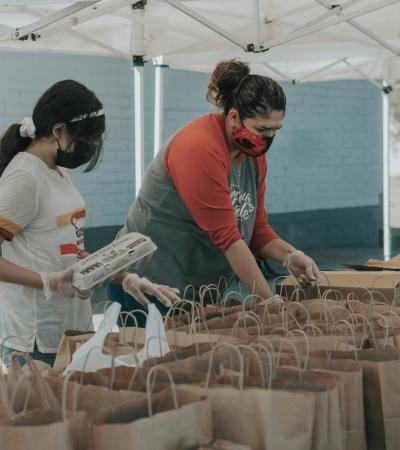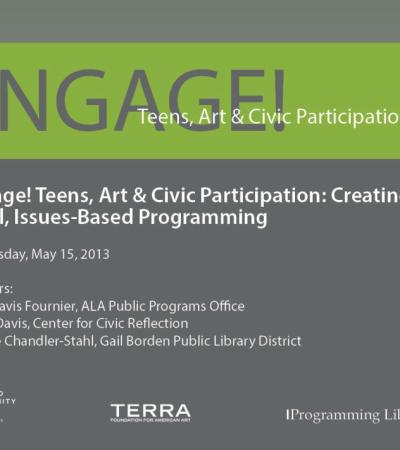The 2015 Pew Research report "Multiracial in America: Proud, Diverse and Growing in Numbers" found that 6.9 percent of all Americans 18 years and older identified as multiracial. The University Library at the University of Michigan planned a yearlong exploration into interracial/multiracial issues, beginning with a faculty panel on how multiracialism influences their academic work. Later in the academic year we will show four films, have a student panel, and invite a multiracial performance artist to campus.
Advanced Planning
This event series was planned by a nine-person committee from the library and across campus. We met about five times over the course of a year to discuss themes, desired outcomes and programming ideas and to identify particular speakers/films. We split into sub-committees for films, panels and marketing. We also had a graduate student intern who helped design the marketing materials, wrote letters of invitation to the speakers, etc.
Marketing
Our graduate student mocked up postcards and fliers to advertise the faculty panel, using the same Wordle image to promote the whole series. We produced fliers and postcards in-house on our color printers and posted them across campus. We also used each committee member's contacts/networks to email the flier to individual faculty and to groups/departments. Some faculty brought their classes, while others encouraged attendance for extra credit.
We have also marketed the session to the community via Facebook, Twitter and through various social justice groups. We used our library website to advertise the session and asked local radio and news media to promote and cover the event.
Budgeting
With the exception of the performance artist, we are doing all this programming on the cheap! For marketing, we used in-house printers and card-stock/paper. Refreshments cost $30 to $50 per event, for a total of $200. We provided no honoraria (except for the performance artist), we used local speakers for the panels, and committee members host the films and guide the discussions.
The performance artist, Fanshen Cox, required a greater investment, and we worked with all our collaborating units to raise the $5,000 needed to bring her to campus. Several of the planning committee members saw Cox perform at the Critical Mixed Race Conference at DePaul University last November and thought she was fantastic. Her mixed-race experience encompasses many different groups.
Day-of-event Activity
For the panel discussion, our facilities crew prepared our gallery/presentation space auditorium-style. We had 100 chairs, a laptop with projection, a stage with three comfy chairs and microphones, and we recorded the session due to many requests for viewing the session at a later date. The faculty panel was 90 minutes long, and we arrived 30 minutes ahead of time to set up refreshments and ensure the equipment worked properly. We sent around a sign-up sheet to the attendees so we could notify them when the rest of the series sessions had been scheduled. We also had three people to help with clean-up after the session.
Program Execution
I started the panel with a presentation about why this topic is so important in the academy and in the country. (Download the presentation under Attachments at right.) The chair of the program committee introduced the speakers and moderated the session. Each of three panel members were given 15 to 20 minutes to present, and then we opened the floor for questions. Because the session was being recorded, each panelist signed a release form at the session, and questions had to be spoken into a microphone. We had two committee members circulating microphones in the audience.
The program was wonderful, because each presentation was so different! Ed West, a photographer, shared beautiful images of his family from when he was growing up, and he shared images of multiracial people from around the world. Martha Jones shared her discovery that she is not "just" black/white, but also has First Nations ancestry — a surprise to her because her family did not talk about their Native American history as she was growing up; researching her family made her realize that there were many secrets in her family. Mark Kamimura talked about being mixed Hawaiian and Mexican American, and how reading the writings/research of other mixed-race people was defining for him; it changed his life and made him realize he wanted to do his own research on mixed-race people. All three agreed that "place" is very important to how they developed their multiracial identities. Where they grew up and where their families called home was significant to their identities.
Fifty-two people attended the panel discussion. Our campus newspaper covered the event, and we were also contacted by Heidi Durrow, author of "The Girl Who Fell from the Sky," to appear on her podcast.
Our film screenings will take place later in the academic year, in November 2015 and January 2016. The filmes are "One Big Hapa Family" (2010), "What Are You Anyways?" (2005), "Chasing Daybreak: A Film about Mixed Race in America" (2006), and "Crossing the Line: Multiracial Comedians" (2007).
Advice
Having a large planning committee is always difficult (coordinating meetings, duties, etc.), but it was beneficial in order to have all the stakeholders at the table. We used all our networks/contacts with faculty and students to choose speakers. It was very helpful to have students on the planning committee; their networks were very different from the rest of the committee members.
Supporting Materials
- Feedback (Coming Soon!)
- Programming Librarian Facebook Group



